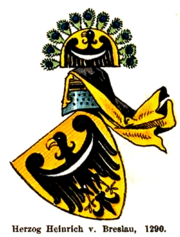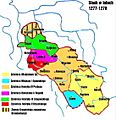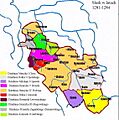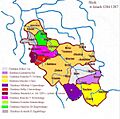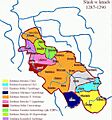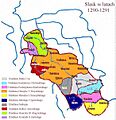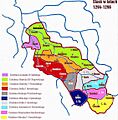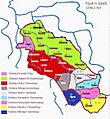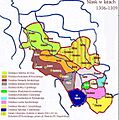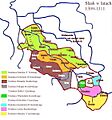Duchy of Silesia facts for kids
Quick facts for kids
Duchy of Silesia
|
|||||||||||||||||||
|---|---|---|---|---|---|---|---|---|---|---|---|---|---|---|---|---|---|---|---|
| 1138–1335 | |||||||||||||||||||
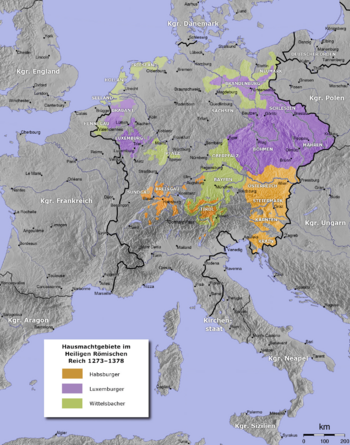
The Holy Roman Empire in the mid-14th century
|
|||||||||||||||||||
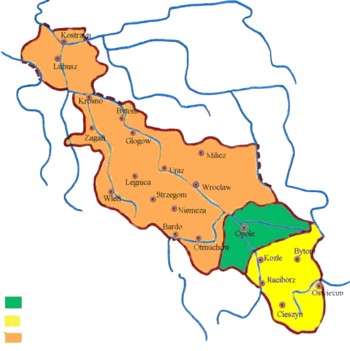
Territorial development of the Duchy of Silesia in the period 1185–1201: Fragmentation begins with
Opole (green) and Racibórz (yellow) splitting off |
|||||||||||||||||||
| Status | Province of Poland | ||||||||||||||||||
| Capital | Wrocław | ||||||||||||||||||
| Religion | Roman Catholic | ||||||||||||||||||
| Government | Feudal monarchy | ||||||||||||||||||
| Historical era | High Middle Ages | ||||||||||||||||||
|
• Established
|
1138 | ||||||||||||||||||
| 1146 | |||||||||||||||||||
|
• Racibórz split off
|
1172 | ||||||||||||||||||
|
• Opole split off
|
1172 | ||||||||||||||||||
|
• Głogów split off
|
1177 | ||||||||||||||||||
|
• Głogów reintegrated
|
c. 1185 | ||||||||||||||||||
| 1241 | |||||||||||||||||||
|
• Lubusz split off
|
1241 | ||||||||||||||||||
|
• Lubusz reintegrated
|
1242 | ||||||||||||||||||
|
• Legnica split off
|
1248 | ||||||||||||||||||
| 1335 | |||||||||||||||||||
|
• Land of the
Bohemian Crown |
1348 | ||||||||||||||||||
|
|||||||||||||||||||
| Today part of | Poland Czech Republic Germany |
||||||||||||||||||
The Duchy of Silesia was a medieval duchy (a territory ruled by a duke) in the historic Silesian region of Poland. Its capital city was Wrocław. It was formed in 1138 under the Piast dynasty, a powerful Polish ruling family.
Soon after it was created, the Duchy of Silesia began to break apart into many smaller Silesian duchies. By 1327, the remaining Duchy of Wrocław and most other Silesian duchies became part of the Kingdom of Bohemia. This change was made official in 1335 when the Polish King Casimir III the Great gave up his claims to Silesia in the Treaty of Trentschin.
Contents
Geography of Silesia
When the Duchy of Silesia was first established, it covered the area around the upper and middle parts of the Oder river. To the south, the Sudetes mountains formed a natural border with the lands of Bohemia and Moravia. This border was agreed upon in 1137 with the Bohemian duke Soběslav I.
To the west, Lower Silesia bordered German lands. The Bóbr and Kwisa rivers marked this western boundary. Silesia was also next to other Polish regions: Greater Poland to the north and Lesser Poland to the east. The Przemsza and Biała rivers separated these areas.
The borders of the duchy changed a bit over time. For example, when the duchy was re-established in 1163 for the sons of Władysław II the Exile, it included Lubusz Land. This land was later sold to the Margraves of Brandenburg in 1248. In 1177, some areas from Lesser Poland were added to Upper Silesia. These areas later returned to the Polish Crown after Silesia became a Bohemian territory in 1335.
History of the Duchy

The Duchy of Silesia began as the "Silesian Province." It was one of five main provinces created in medieval Poland by the will of Duke Bolesław III Krzywousty in 1138. His oldest son, Władysław II the Exile, was given control of Silesia. He was also the "Senior Duke" or "High Duke" of Poland, meaning he was the most powerful ruler in the country.
However, Bolesław's will did not stop his sons from fighting over who would rule. In 1146, Władysław tried to take control of the entire Kingdom of Poland but failed. He lost his title as Senior Duke and had to flee to the Holy Roman Empire. His half-brother, High Duke Bolesław IV the Curly, then took control of Silesia.
Return of Władysław's Sons
In 1163, Władysław's sons were able to return to Silesia. They had help from Emperor Frederick I Barbarossa of the Holy Roman Empire. At first, they ruled Silesia together from Wrocław. But by 1172, they started fighting among themselves. This led to the first major split of the duchy. This was the beginning of many divisions that created numerous Silesian duchies over the next centuries.
- Władysław's oldest son, Bolesław I the Tall, received Lower Silesia. His main city was Wrocław, so his lands were sometimes called the Duchy of Wrocław.
- His second son, Mieszko I Tanglefoot, received a smaller part in Upper Silesia. He made his home in Racibórz, creating the Duchy of Racibórz. To make up for his smaller share, he was given more land by the Polish High Duke Casimir II the Just in 1177.
More Divisions
Bolesław I's oldest son, Jarosław, worried he wouldn't inherit anything. So, his father gave him land around Opole, creating the Duchy of Opole. Jarosław had to agree to become a church leader and not marry. The youngest brother, Konrad Spindleshanks, also claimed his rights around 1177. He received lands around Głogów, which became the first Duchy of Głogów. However, Bolesław I outlived both his son Jarosław and his brother Konrad. So, these lands returned to him in 1190 and 1201.
When Bolesław I died in 1201, his son Henry I the Bearded took over. Henry I faced many challenges from his relatives and German neighbors. In 1202, his uncle Mieszko I invaded and took the Opole territory. This officially separated Upper Silesia from the rest of the duchy. Henry I also had to fight to keep Lubusz Land in the northwest.
In 1230, Henry I became the guardian of his young nephews after his cousin died. This meant he ruled over all of Silesia again for a time. In 1232, he became High Duke of Poland. When he died in 1238, his son Henry II the Pious took over. It seemed like Poland might become united again under the Silesian Piasts.
The Mongol Invasion and Further Splits
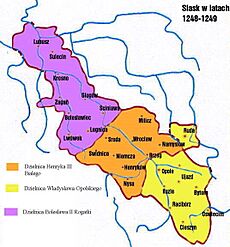
Henry II had to give up control of Upper Silesia to his cousin in 1239. He also continued to defend Lubusz Land from attacks. The hope for a united Poland ended with the Mongol invasion of Poland in 1241. Henry II was killed in the Battle of Legnica.
His oldest son, Bolesław II the Bald, could not become High Duke of Poland. After getting Lubusz back, he had to divide his Silesian lands with his younger brothers in 1248:
- Bolesław II moved his home to Legnica in the west. This created the Duchy of Legnica with his youngest brother, Konrad. Bolesław later sold Lubusz to the Brandenburg rulers. In 1251, Konrad forced Bolesław to give him the Duchy of Głogów.
- The city of Wrocław went to his younger brothers, Henry III the White and Władysław. This established the Duchy of Wrocław itself.
The Silesian duchies continued to split into smaller and smaller pieces over the years. This was part of the larger fragmentation of Poland. Henry III's son, Henry IV Probus, ruled Wrocław from 1270. He even became High Duke of Poland in 1288. But he died in 1290 without any children, ending his family line.
His cousin, Henry V the Fat, took over. He managed to unite the duchies of Wrocław and Legnica again. However, when he died in 1296, his lands were once again divided among his sons.
Silesia Joins Bohemia
The second son, Duke Henry VI the Good, faced challenges from his older brother. To protect his lands, Henry VI signed an agreement in 1327 with King John of Bohemia. Most of the Silesian duchies had already become "vassals" (meaning they owed loyalty and service) to the Kingdom of Bohemia in the early 1300s.
When Henry VI died in 1335 without male heirs, his duchy passed peacefully to the Bohemian kingdom. This happened because the Polish king Casimir III had given up his claims to Silesia in the 1335 Treaty of Trentschin.
Silesia officially became part of the Lands of the Bohemian Crown. This was confirmed by King Casimir III and King Charles IV in the 1348 Treaty of Namslau. However, a few Upper Silesian duchies remained with Poland.
Dukes of Silesia
Here are the main dukes who ruled Silesia:
- Władysław the Exile (1138–1146): The first duke, also High Duke of Poland. He was removed from power.
- Bolesław the Curly (1146–1163): Władysław's half-brother, who took control.
- Bolesław I the Tall (1163–1201): Władysław's oldest son, who returned to power.
- Henry I the Bearded (1201–1238): Bolesław's son. He also became High Duke of Poland in 1232.
- Henry II the Pious (1238–1241): Henry I's son. He was also High Duke of Poland and died in the Battle of Legnica.
- Bolesław II the Bald (1241–1248): Henry II's son. He became Duke of Legnica after the 1248 division.
- Henry III the White (1248–1266): Bolesław II's brother. He ruled jointly with his brother:
- Władysław (1248–1270): Henry III's brother. He also became Prince-Archbishop of Salzburg.
- Henry IV Probus (1266–1290): Henry III's son. He became Duke of Wrocław in 1270 and High Duke of Poland in 1288. He had no children.
- Henry V the Fat (1290–1296): Bolesław II's son. He was Duke of Legnica since 1278.
- Henry VI the Good (1296–1335): Henry V's second son. He was under the care of:
- Bolko I the Strict (1296–1301): Bolesław II's son.
- King Wenceslaus II of Bohemia (1301–1305)
- Bolesław III the Generous (1305–1311): Henry V's oldest son, Duke of Legnica since 1296.
Since Henry VI had no sons, his lands were inherited by King John of Bohemia.
Maps of Silesia
These maps show how the Duchy of Silesia kept breaking into smaller parts. They also show how the borders of these smaller duchies changed over time.
What Happened Next?
After 1526, the House of Habsburg family inherited Bohemia. This meant the Silesian duchies slowly came under the control of the Austrian Habsburg rulers. However, in 1740, King Frederick II of Prussia invaded Silesia. He took most of it during the First Silesian War. The part of Silesia that remained under Austrian control became the Duchy of Upper and Lower Silesia in 1742.
The parts of Silesia that had stayed with Poland were later taken by the Kingdom of Prussia and the Habsburg monarchy during the Partitions of Poland in the 1700s. The Austrian Duchy of Upper and Lower Silesia lasted until 1918. After that, it was divided between the Second Polish Republic and Czechoslovakia.




